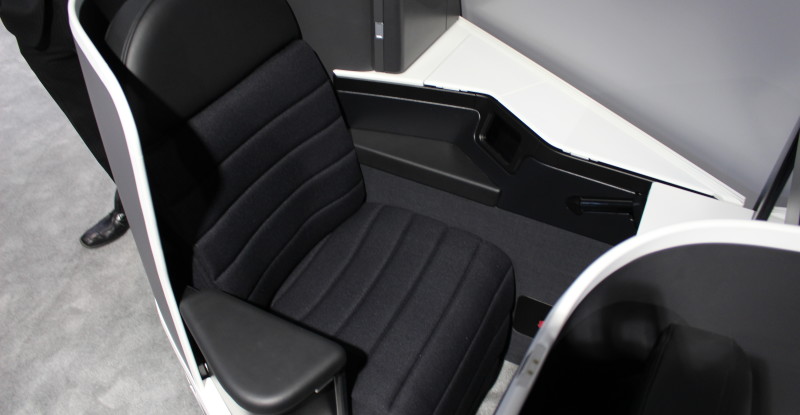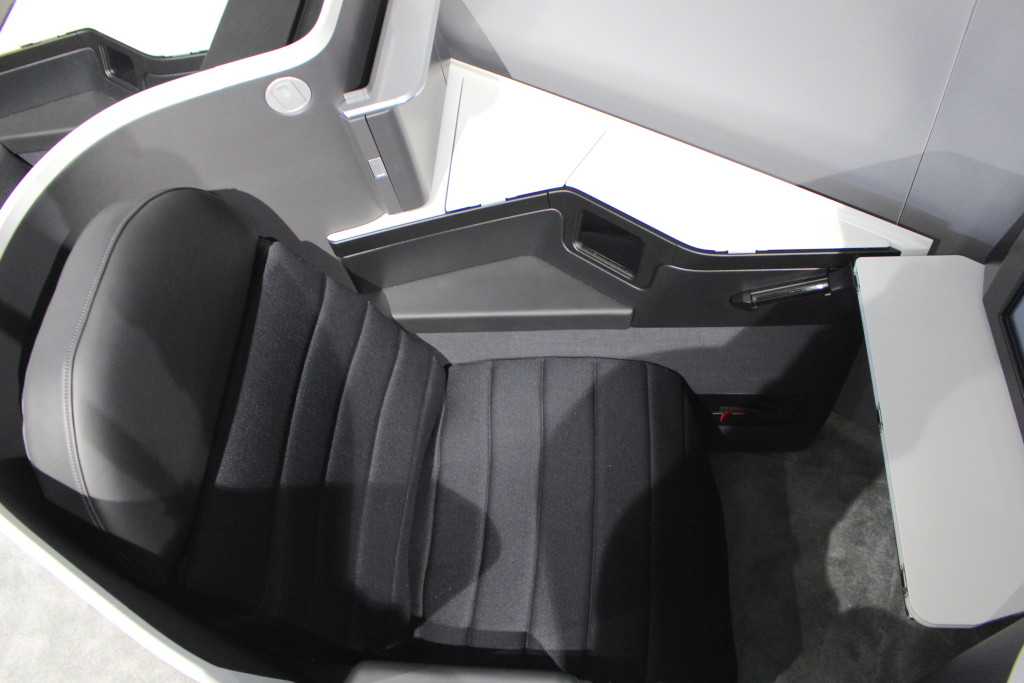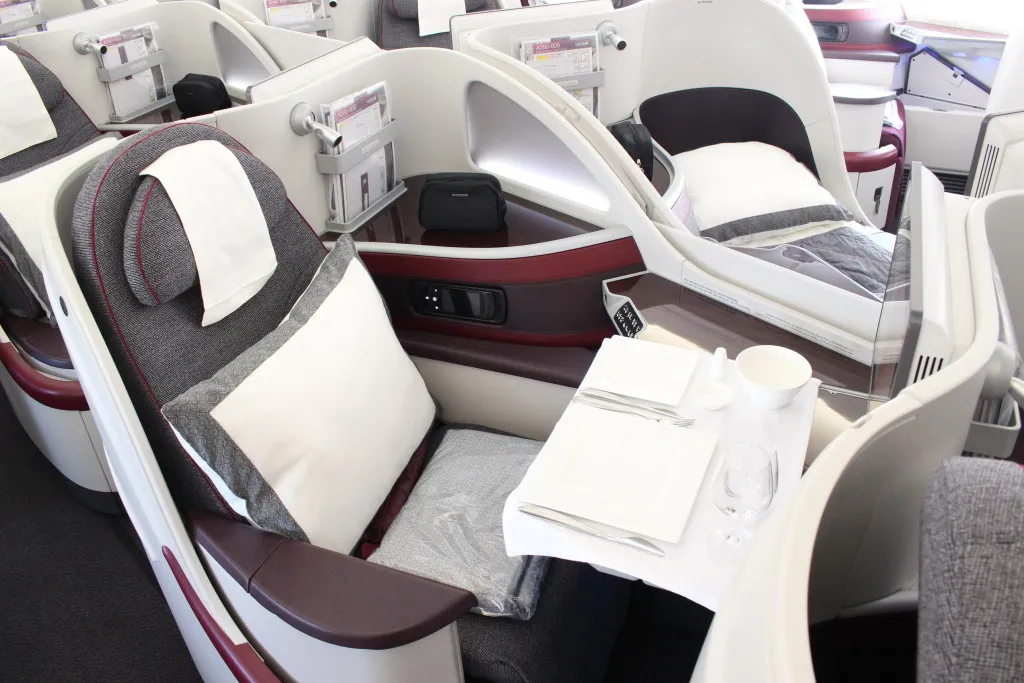Virgin Australia’s new Airbus A330 business class certification is suffering repeated failures of the passenger restraint system related to 16G oblique angle impact survivability for the B/E Aerospace Super Diamond seats, RGN can exclusively reveal after obtaining information from the European Aviation Safety Agency (EASA) and US Federal Aviation Administration (FAA).
In a statement, EASA says, “The Virgin Australia A330 STC [supplemental type certification] project has suffered huge delays because of repetitive failures in the seat dynamic testing, mainly caused by inadequacy of the airbag design.”
There are troubling parts to this saga.
First, Virgin Australia chose to increase the angle by which the seats are angled away from the aircraft centreline by 6 degrees to 30 degrees, yet told RGN that the industry regulations for how safety testing is conducted “changed during the development stage of the project, which changed the original rollout timetable”.
Three regulators in three separate jurisdictions are now manifestly denying that this is the case.
Second, B/E Aerospace’s Super Diamond seat was previously certified for a 24° angle for Qatar Airways, and Virgin Australia could have chosen this with a minimum of recertification requirement. Super Diamond is certified at 24° already for the 787, A350 and A380 upper deck; the latter is very close in usable width to the A330.
Third, the airline and the seatmaker could simply have avoided the airbag issue entirely by adding a shoulder safety belt, like numerous other airlines have done to ease certification since the development of non-forward-facing seats at oblique angles to the centreline.
Fourth, B/E Aerospace’s public statements about its competitors’ delivery delays and its own 100% on-time record would now appear to have been a fair amount of hubris.
Non-forward-facing seats have required safety measures for decades
EASA explains, “The B/E Super Diamond seats proposed for installation on the Virgin Australia (VOZ) A330 aeroplanes are installed at 30 degrees with respect to the aircraft centreline and are not directly compliant with JAR 25.785 (c) Change 13, which requires seats installed at more than 18 degrees to be equipped with a shoulder belt or an energy absorbing rest.”
In a separate statement, the FAA notes, “This part of the regulation has not changed since 1969, but these seats do not have an energy absorbing rest or shoulder harness as required by the regulation. The FAA previously certified installations of the Super Diamond seats using a finding of equivalent safety to the regulation based on the condition that the occupant of the seat experienced the same effects as an occupant of a normal forward facing seat during the emergency landing conditions specified in 14 CFR 25.562.”
The EU and US regulators refer to the regulations by different names, but the section numbers are harmonised. Section 25.562 (b) is the “emergency landing dynamic conditions” specification around the forces that must be survived, while Section 25.785 (d) states: “Each occupant of a seat that makes more than an 18 degree angle with the vertical plane containing the airplane centerline must be protected from head injury by a safety belt and an energy absorbing rest that will support the arms, shoulders, head and spine, or by a safety belt and shoulder harness that will prevent the head from contacting any injurious object. Each occupant of any other seat must be protected from head injury by a safety belt and, as appropriate to the type, location and angle of facing of each seat, by one of more of the following:
(1) A shoulder harness that will prevent the head from contacting any injurious object.
(2) The elimination of any injurious object within striking radius of the head.
(3) An energy absorbing rest that will support the arms, shoulders, head, and spine.
The ESF process can define alternative safety certification
EASA and other regulators provide the opportunity for airframers, seatmakers and airlines to seek an Equivalent Safety Finding (ESF) from regulators in order to demonstrate that new technology can ensure a similar level of safety to that required in the regulations.
It is this certification that any airframer, seatmaker or airline must obtain if they wish to avoid installing a shoulder harness, having to eliminate any object within range of the head, or adding an energy absorbing rest.
In the case of the Virgin Australia business class seat, EASA says, “The ESF approach is based on showing that the installation of an inflatable restraint system compensates the absence of a shoulder belt or an energy absorbing rest. The approach was developed by EASA in coordination with the FAA back in 2009 and requires comparison between occupant internal forces and moments measured on the angled seats with the internal forces and moments that would be measured on the same seats if installed at 18 degress.”
Qatar Airways achieved a Super Diamond A350 ESF at a 24° angle
“The installation of the VOZ seats will be certified through an Equivalent Safety Finding similar to that granted by EASA for the A350-900 Qatar Airlines B/E Super Diamond seats (ref. A350 ESF CRI D-30, which is published on the EASA website),” EASA states.
The ESF concluded in 2014: “The passenger seats that are installed in the A350 aircraft at angles above 18 degrees with the aircraft longitudinal axis are considered to ensure an equivalent level of safety to a literal compliance to 25.785 (d) provided that the design of the seat and the surrounding items is demonstrated to enable the occupant to align during the impact with the deceleration vector specified in CS 25.562 (b).”
Virgin Australia’s decision to increase to 30° is the problem, not regulation changes, nor the A330
EASA notes that the specific issue with certifying the Super Diamond seats for the A330 is the angle that Virgin Australia has chosen for its seats: “The difference between the Qatar A350 Super Diamond seats and the VOZ A330 seats is the angle of installation respectively 24 and 30 degrees, which makes [it] more difficult to substantiate the ESF for the VOZ seats.”
“It must be noted that the VOZ A330 seats will be the first seats with installation angle of 30 degrees certified by EASA using the ESF approach described in CRI D-30,” EASA concludes in its statement to RGN.
The angles seem somewhat counterintuitive given that the A350 has a larger cabin than the A330, by over a foot (32cm: 5.96m on A350 vs 5.64m on the A330). Normally, a larger cabin would suggest an airline point the seats away from the centreline in order to fit in more seats, and this is what other airlines have done.
Virgin Australia, however, would appear to have decided to add an extra six degrees in order to maximize density. This seems to have been an unwise decision and one that has caused significant delay.
Misdirection and obfuscation are even more troubling than delays
Seat manufacturing and certification delays happen. This is a fact of life in the aviation industry, despite clear signalling from regulators, a healthy and effective set of communications, and specific requirements laid out in regulations — the basic requirements of which have not changed since for 46 years.
Yet, disappointingly, information provided by EASA and the FAA conflicts significantly with a statement from Virgin Australia, which blamed firstly changes in the regulation and secondly the need to certify the seat for the A330.
To the first suggestion, as the US FAA put slightly more bluntly in a statement on this topic, “This part of the regulation has not changed since 1969, but these seats do not have an energy absorbing rest or shoulder harness as required by the regulation.” Australia’s Civil Aviation Safety Authority (CASA), EASA and the FAA all confirm that regulation changes are not to blame. Airbus, meanwhile, said that the need for Virgin Australia and B/E Aerospace to seek a supplemental type certification is “a perfectly usual requirement when airlines update cabins of in-service aircraft”.
To the second, the A330 is not the problem here. Its cabin is narrower than the A350, A380 and 787, which are all certified for Super Diamond at 24°. Adding the extra six degrees is not required for the A330; if anything, the A330’s narrower cabin means seats would angle closer to the centreline. The more oblique angle Virgin Australia chose changes the angle at which the test dummy (and, let’s not forget, real passengers in the event of an impact) hit the airbag which is protecting them from the wall. It is entirely unsurprising that regulators required further testing.
“For the QTR [Qatar Airways] A380 seats, the angle of installation is lower and the pitch of installation is higher than for the VOZ A330 seats. This makes the VOZ A330 seats more critical than the QTR A380 seats,” says EASA. “For the VOZ seats, an airbag similar to that of the QTR A380 (and A350 seats) was initially proposed for certification. However, such airbag design was not found to be adequate to substantiate an Equivalent Safety Finding for the VOZ A330 seats. Therefore a wider and better performing airbag had to be developed to mitigate the higher injury risk for the occupant of the A330 VOZ seats.”
The regulators are clear that Virgin Australia’s and B/E Aerospace’s decision to change the angle and rely on an airbag solution never tested at that angle is to blame for the delays.
RGN is still awaiting further comment and answers to detailed questions on the issue from Virgin Australia and comment from B/E Aerospace.












